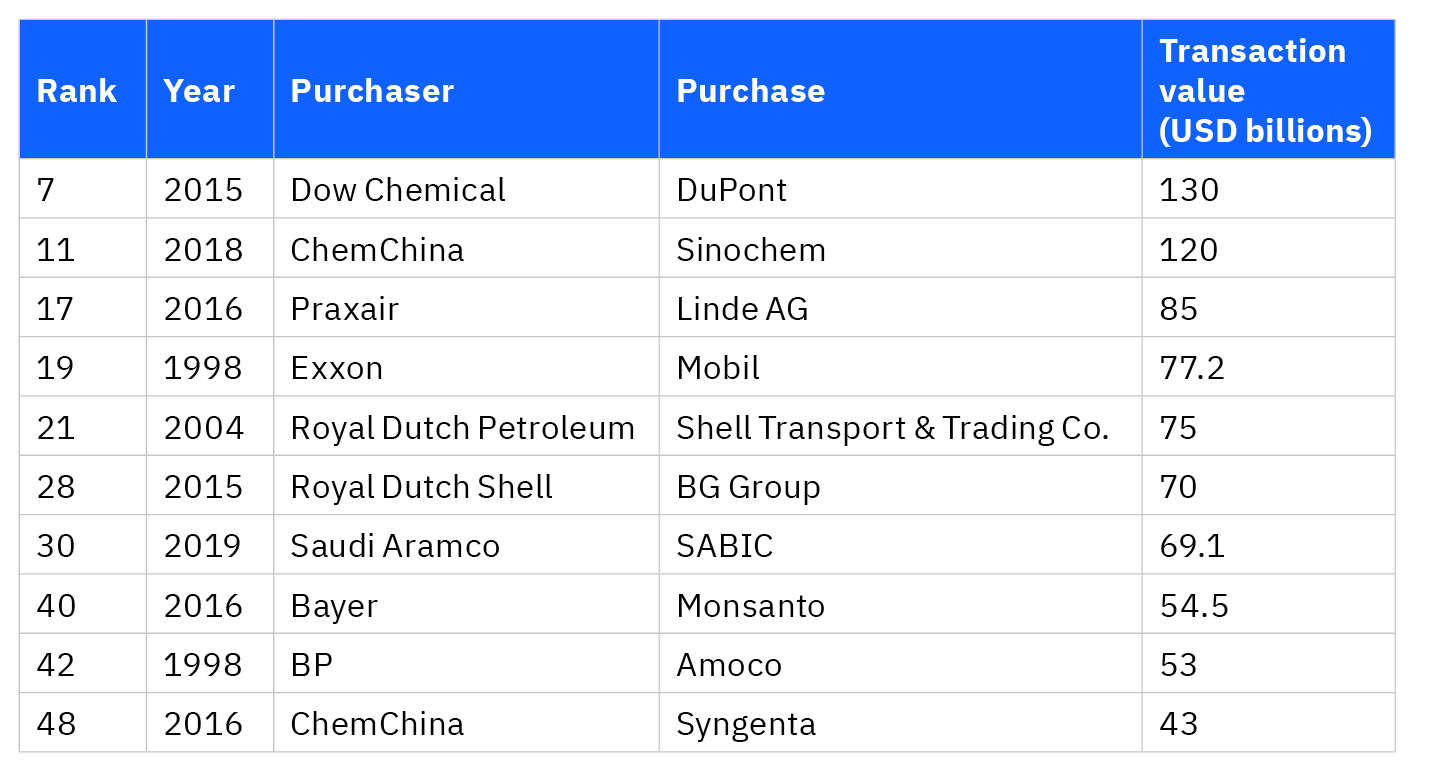AI-assisted acquisitions
The chemicals and petroleum industry has long used M&A as a critical strategy. When examining the history of M&A deals across industries, chemicals and petroleum represents 20 percent of the 50 largest deals of all time (see figure below). In 2019, chemicals and petroleum deals were valued at over USD 550 billion.
Pre-pandemic M&A transactions reflect how chemicals and petroleum companies were responding to the disruptive global environment prior to COVID-19. Using AI-enabled strategies to address today's disruptions of global political and economic uncertainty—decreased demand for oil, lower levels of investment, and accelerating energy transition—can help these organizations re-establish progress.
Chemicals and petroleum industries represent a fifth of the largest 50 M&A deals in history

To better understand strategies behind M&A success, the IBM Institute for Business Value (IBV), in cooperation with Oxford Economics, surveyed leaders from 720 organizations across the chemicals and petroleum, electronics, healthcare, and life sciences industries. Respondents represented 18 countries and included 220 chemicals and petroleum executives. Each respondent holds overall responsibility for the M&A process, from the definition of M&A strategy to post-purchase integration.
Companies buy for the same reasons as organizations in other industries: to expand scope or scale. The Bayer/Monsanto deal is an example of scope expansion around crop sciences, while Saudi Aramco’s acquisition of SABIC was scale driven to expand downstream operations in refining and petrochemicals. But beyond these basic reasons, most companies have a more nuanced and layered set of buying criteria.
In fact, survey responses yield more than 40 unique combinations of reasons behind their M&A pursuits. Recent M&A transactions reflect how chemicals and petroleum companies are responding to the current global environment (excluding the disruption caused by the COVID-19 pandemic). Each segment within the industry pursues different strategies in its M&A:
In chemicals, the merger of Praxair/Linde AG created the world’s largest industrial gas company. Synergies were driven by scale benefits, cost savings, and efficiency improvements.
In upstream oil and gas, efficiency and scope have driven recent transactions. For example, Occidental Petroleum’s acquisition of Anadarko created a combined company that is the largest player in the Permian Basin and one of the top producers in the Gulf of Mexico. The deal is expected to generate USD 3.5 billion per year in cost savings and capital spending cuts and allows Occidental to apply its Permian Basin expertise to Anadarko’s Texas and Colorado oilfields. BP bought BHP Billiton’s US shale oil and gas assets for USD 10.5 billion to increase its US onshore oil and gas resources by 57 percent. Investment in deep-water assets, such as ExxonMobil in the Guyana-Suriname Basin in South America and Shell in Brazil, suggests these companies are positioning their portfolios to protect themselves from price volatility.
In midstream oil and gas, scale is the rationale behind the Energy Transfer Partners USD 60 billion merger with Energy Transfer Equity. The combined entity created a more simplified ownership structure, improved its overall cost of capital, and allowed Newco to continue pursuing growth capital projects and strategic merger and acquisition transactions.
In downstream oil and gas, scale through better integration across the value chain drove Marathon Petroleum’s acquisition of Andeavor for USD 35.6 billion. The merger linked Andeavor’s gathering and transportation infrastructure in West Texas to Marathon’s United States Gulf Coast refinery to provide access to low-cost crude oil supply.
Each of these M&A deals is complex, time-consuming, and inherently risky. Our survey respondents indicated that it takes 50 weeks (median) to execute the M&A process from strategy to integration. After integration, the merged companies take an additional 80 weeks (median) to achieve about 60 percent of projected synergies. And it took 85 weeks post-integration for respondents to realize a profit.
It’s mission-critical for buyers and sellers to know if their organizations can blend successfully. Until two companies move beyond “dating” to merging, “mismatches” are a risk.
Corporate development, and M&A in particular, will always be a human-plus-machine partnership. The complexity of products/services, markets, and revenue models necessitates an executive focus on technology-enabled M&A approaches and strong governance and execution. This report explores those details and concludes with a four-step Action Guide to help you build a modern M&A capability that can drive effective, inorganic portfolio growth.
Meet the authors
David Womack, Global Director of Strategy and Business Development, Chemicals and Petroleum industryPaul Price, Director, IBM M&A Integration and Corporate Development
Lisa-Giane Fisher, Leader, Middle East and Africa, and Global Benchmark Research leader, Utilities industry, IBM Institute for Business Value
Spencer Lin, Global Research Leader, Chemicals, Petroleum, and Industrial Products, IBM Institute for Business Value
Originally published 03 June 2020


